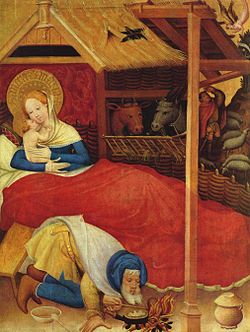Conrad von Soest | |
|---|---|
 Nativity from the Niederwildungen Altarpiece | |
| Born | 1370 |
| Died | 1422 |
| Nationality | German |
| Movement | International Gothic |
Conrad von Soest, also Konrad in modern texts, or in Middle High German Conrad van Sost or "von Soyst", (born around 1370 in Dortmund; [1] died soon after 1422) was the most significant Westphalian artist and painted in the so-called soft style of International Gothic. He played a leading role in the introduction of this International Courtly Style to Northern Germany around 1390 and influenced German and Northern European painting into the late 15th century. [2] He was the master of a thriving workshop and was accepted into the social circle of the cosmopolitan patrician elite of Dortmund. Dortmund was then a leading and very prosperous member of the influential Hanseatic League. [3]

